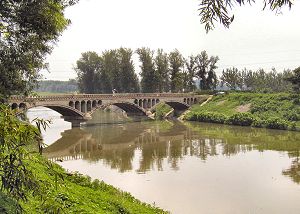Bahe (Ba River) came to fame in 1292 when it was elevated from a "simple" river to an essential waterway, which carried the main overspill water from Jishuitan to the Grand Canal via Wenyu River thus preventing flooding in the emperor's capital.

Bahe originates at the extant eastern Yuan City Moat. Guo Shou Jing had a canal excavated from Jishuitan straight eastward passing through the former city wall a little north of Dongzhemen. From there Bahe joins the city moat northbound, then assumes its independant eastbound course until it finally merges with Wenyu River.
The river takes on many faces in its course. At its origin the river runs gracefully between residential areas, mostly with plenty of water.

In its second phase it traverses small parks and construction sites. The river passes almost unseen under the intersection between Ring Road 4 and the Airport Expressway. In this stage the river has little water, is quite polluted, filled with garbage and has a rather foul smell.
The third phase passes through small villages and farming communities. It has a varying amount of water. Shortly after flowing under Ring Road 5, Baha is joined by its tributary Liangma River. This adds to overall water supply, some of which again is diverted into drainage and farming canals.
In its fourth and final phase Bahe reassumes some of its graceful appearance from its origin. There is generally enough water and the riverbed is romantically lined with weeping willows. The river ends (photo) with a strong flow into the Wenyu River some four kilometers north of Tongxian city.
Use the navigation buttons top right to see pictures of Bahe's course. The slide shows can be paused by hovering the mouse over a photo.